
views
X
Trustworthy Source
Federal Trade Commission
Website with up-to-date information for consumers from the Federal Trade Commisson
Go to source
Writing the Body of the Letter

Keep your tone clear, rational, and positive. Remember that the customer service representative probably has nothing to do with the faulty product or service. You’ll lose credibility if you use threatening or foul language, and getting angry won’t convince anyone at the company to help you. Instead, back your complaint with facts and use calm, focused language throughout your letter.
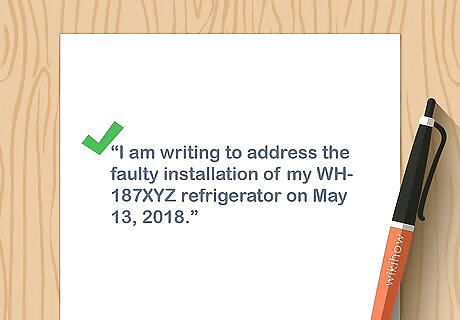
State your issue in the first sentence. Get straight to the point instead of beating around the bush. Open with a sentence that immediately informs the reader of the nature of your complaint. An example opening line would be, “I am writing to address the faulty installation of my (model name or number) refrigerator on September 13, 2018.”

Summarize the events that prompted your complaint in 2 to 3 sentences. Explain why you’re dissatisfied with the product, service, or situation that has prompted your complaint. Be sure to keep your summary concise; stick to a couple of sentences. Your reader’s eyes will glaze over if you write a novel about the issue. A concise summary would be, “The refrigerator is defective, and was never able to reach a temperature cold enough for safe food storage. Additionally, wood floors from the front entrance to the kitchen were scratched deeply during delivery and installation.”
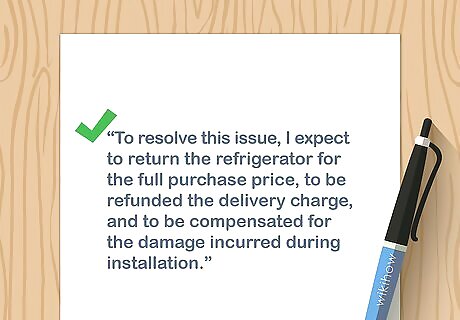
Explain how you want the situation resolved. Early on in the letter, clearly describe how you want the recipient of the complaint to fix the situation. For instance, you might write, “To resolve this issue, I expect to return the refrigerator for the full purchase price, to be refunded the delivery charge, and to be compensated for the damage incurred during installation.”Variation: If your first paragraph is on the longer side and your proposed resolution is more than 2 lines, dedicate the second paragraph to the resolution. Aim to limit your paragraphs to 4 lines.
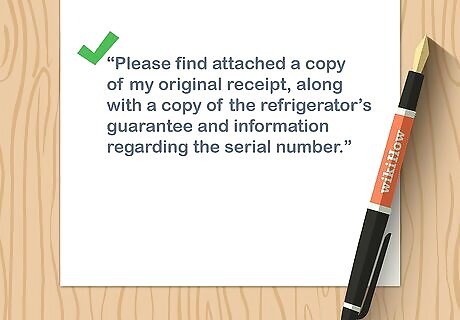
Provide further details in the remaining body paragraphs. Continue building your case with specific facts. If applicable, reference photographs, inspection reports, repair estimates, and other documents that support your claims. For instance, the next paragraph after your summary and proposed resolution could reference photographs and mention estimated costs to repair damage due to a botched installation. Then, you could describe how you’ve called the customer service line, spoke to Matthew, and exchanged emails with Todd, but still haven’t gotten any true assistance with the matter.
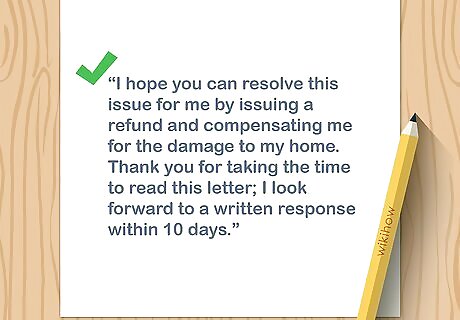
Include specific follow-up actions and deadlines in the final paragraph. Restate how you want the situation to be resolved, and let the recipient know how you expect them to respond. Keep your tone firm, but conclude on a positive note. For instance, you might write, “I hope you can resolve this issue for me by issuing a refund and compensating me for the damage to my home. Thank you for taking the time to read this letter; I look forward to a written response within 10 days.”
Structuring Your Letter
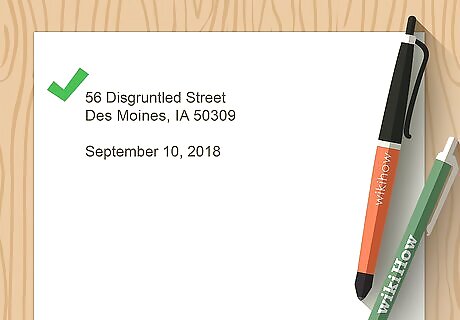
Write your address and the date on the top left margin. Don’t include your name when you write your address at the top of the letter. If you live in the United States, put your street address on the first line, then write your city, state, and zip code on the next line. Press “Enter” twice to skip a line, then add the date under the sender’s address. In a formal letter, the sender’s address goes at the top left corner. To lend your complaint credibility, structure your letter formally. Tip: If you live outside of the U.S., check your nation’s postal conventions. For instance, if you live in the U.K., format your address like this: 10 Wardour StreetLONDONW1D 6QF
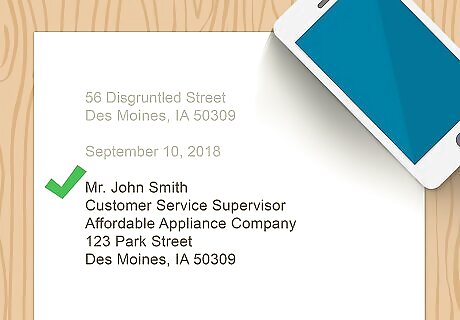
Skip a line, then add the recipient’s address. Skip a line under the date, then write the name of the contact person, if you know of one, along with a courtesy title (such as Mr. or Ms.). Write the contact person’s title under their name, then add the company name, street address, and city, state, and zip code. The recipient’s address should look like this:Mr. John SmithCustomer Service SupervisorAffordable Appliance Company123 Park StreetDes Moines, IA 50309Tip: If you’re not sure where to send the letter, see if the recipient of your complaint has a website that lists a mailing address and the name of a contact person.
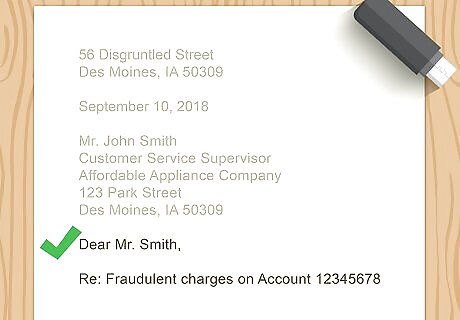
Include a subject line under the salutation. If you’re typing your letter, press “Enter” twice to skip a line after the recipient’s address. Write a salutation, such as “Dear Mr. Smith.” Then skip another line and add “Re:,” followed by the product or service that you’re addressing in your complaint. Just write “Dear (Company Name),” if you don’t know of a contact person. Here’s an example of the salutation and subject line:Dear Mr. Smith,Re: Fraudulent charges on Account 12345678
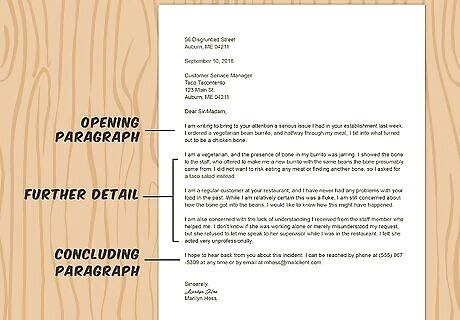
Outline your complaint in the body. After your subject line, skip a line and get to the meat of your letter. The length of your letter’s body will depend on the nature of your complaint. In general, you should be able to include all the necessary information in 3 to 5 concise paragraphs. The letter's body includes an opening paragraph, 1 to 3 paragraphs that add further detail, and a concluding paragraph.
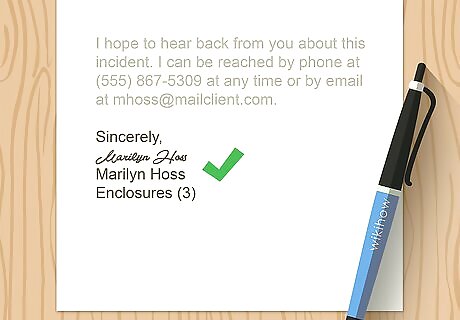
Finish the letter with a closing and signature. Skip a line after the last paragraph, then write a closing, such as “Sincerely,” or “Yours Truly.” Add 4 lines of space after the closing, then type your name; use the space to sign the letter by hand. If you've enclosed any documents, skip a line after your typed name, then write “Enclosures,” followed by the number of documents in parentheses. Align the closing, your typed name, and the enclosure notation to the left. An unsigned closing looks like this:Sincerely,Jane DoeEnclosures (3)
Including Relevant Information

Assemble receipts, contracts, and any other supporting documents. If your complaint is related to a purchase, track down the sales receipt, invoice, or billing statement. Other relevant documents include terms of service, work orders, and warranties. These documents contain important details about the situation; include these details in your letter. It’s also wise to enclose copies of supporting documents with your complaint letter to strengthen your case. Be sure to send copies instead of original documents. If your complaint is related to an account, such as a credit card or bank account, reference your account number in the letter.
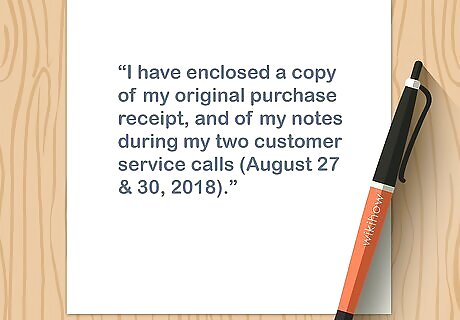
Enclose any correspondence you've had regarding the complaint. If you’ve communicated with the person, company, or organization regarding your complaint, print out any emails or notes from phone conversations. Mention steps you’ve taken to address the issue in the letter, reference the emails or phone calls, and enclose copies of prior correspondence with the letter. Ask for a name whenever you talk to a customer service representative. Having a record that you've spoken to or emailed a specific person increases your credibility.

Include any evidence of additional costs related to your complaint. Send copies of receipts, inspection reports, or estimates for any costs you incurred due to a defective product or botched service. Reference the evidence you've enclosed in the letter, and state that you expect to be compensated for these costs. For example, if your home was damaged during an appliance installation, take photographs of the damage. Get an inspection and quote for repairs from a contractor, and enclose copies of those documents with the complaint letter.




















Comments
0 comment